
Chapter 10: Patterns of Inheritance
10.1 Mendel’s Laws
Genetics is the science of heredity, or how traits are passed from parents to offspring.
Genetics can explain why you share similar characteristics with your relatives, such as eye color, hair color, and height.
Genetics can also explain why there are variations between offspring from one generation to the next.
Virtually every culture in history has attempted to explain observed inheritance patterns.
An understanding of inheritance patterns has always been important to agriculture, animal husbandry, and medicine.
Mendel’s Experimental Procedure
Gregor Mendel was an Austrian monk and scientist who conducted experiments on pea plants in the 1860s.
Mendel's experiments led to the development of the laws of inheritance, which explain how traits are passed from parents to offspring.
Mendel's laws of inheritance are:
The law of segregation: Each parent passes on only one of its two copies of a gene to its offspring.
The law of independent assortment: The genes for different traits are passed on to offspring independently of each other.
Mendel’s theory is called the particulate theory of inheritance because it is based on the existence of minute particles that we now call genes.
Inheritance involves the reshuffling of these genes from generation to generation.
Mendel's work was groundbreaking and laid the foundation for modern genetics.
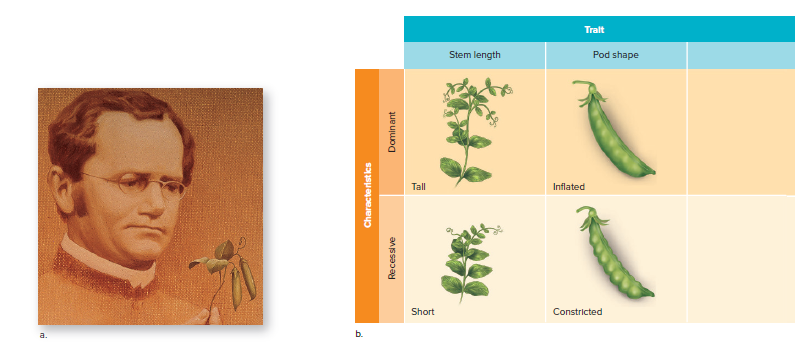
One-Trait Inheritance
Mendel ensured that his pea plants were true-breeding, meaning that they always produced offspring with the same trait as themselves.
For example, Mendel's green-pod plants always produced green-pod offspring, and his yellow-pod plants always produced yellow-pod offspring.
Once Mendel had confirmed that his pea plants were true-breeding, he was ready to perform a cross between two different strains.
Mendel called the original parents the P generation.
The first-generation offspring were called the F1 (for filial) generation.
The second-generation offspring were called the F2 generation.
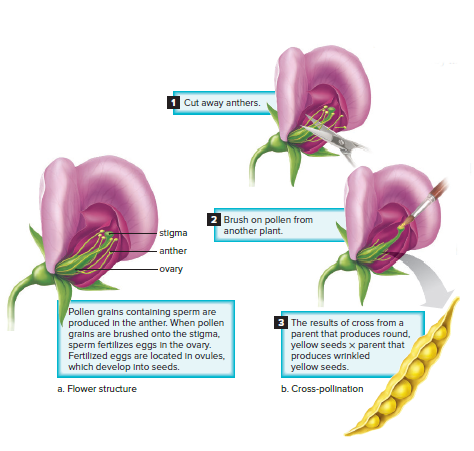
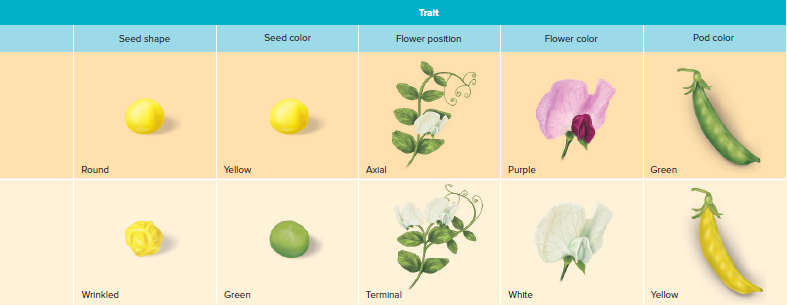
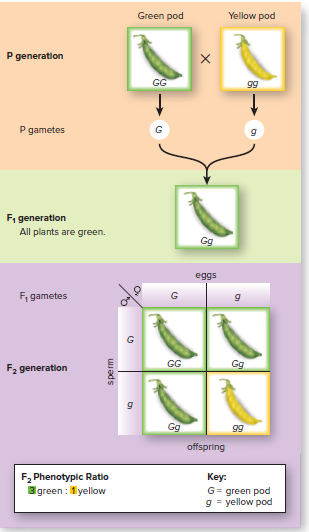
A Punnett square is a diagram that shows all the possible combinations of genes that can be inherited by offspring.
When Mendel crossed green-pod plants with yellow-pod plants, all the F1 offspring (first generation) resembled the green-pod parent.
This did not mean that the yellow-pod trait had disappeared permanently.
When Mendel allowed the F1 plants to self-pollinate, three-fourths of the F2 generation (second generation) produced green pods and one-fourth produced yellow pods.
This 3:1 ratio is evidence that the F1 plants had passed on a factor for the yellow color.
Mendel recognized that the F1 plants produced green pods because the green color was dominant over the yellow color.
This type of cross is commonly called a monohybrid cross.
Mendel's mathematical approach led him to conclude that the following must be true in order to produce a 3:1 ratio in the F2 generation:
The F1 parents contained two separate copies of each hereditary factor, one dominant and one recessive.
The factors separated when the gametes were formed, and each gamete carried only one copy of each factor.
Random fusion of all possible gametes occurred upon fertilization.
One-Trait Testcross
Mendel performed a testcross to determine whether the F1 generation carried a recessive factor.
In a testcross, an individual with a dominant phenotype is crossed with an individual with a recessive phenotype.
If the individual with the dominant phenotype is heterozygous, then half of the offspring will have the recessive phenotype.
Mendel's results from the testcross supported his hypothesis that factors segregate when gametes are formed.
The law of segregation states that:
Each individual has two factors for each trait.
The factors segregate (separate) during the formation of the gametes.
Each gamete contains only one factor from each pair of factors.
Fertilization gives each new individual two factors for each trait.
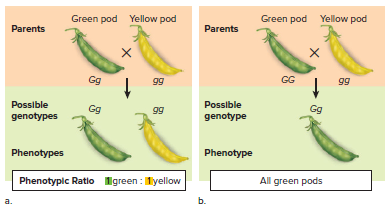
The Modern Interpretation of Mendel’s Work
In the early 1900s, scientists noticed that Mendel's "factors" (now known as genes) behaved in a similar way to chromosomes.
This led to the development of the chromosomal theory of inheritance, which states that genes are located on chromosomes.
Each gene has two copies, called alleles.
The dominant allele is expressed, while the recessive allele is not.
Dominant alleles are denoted by uppercase letters, while recessive alleles are denoted by lowercase letters.
Alleles on homologous chromosomes can be different.
Sister chromatids always have the same alleles.
Genes act as blueprints for traits at the physiological and cellular level.
Environmental factors and gene expression can modify the expression of genes.
During meiosis I, homologous chromosomes (chromosomes that are similar in size and shape) pair up and exchange genetic material.
After meiosis I, each gamete (sex cell) has one copy of each chromosome.
When two gametes fuse during fertilization, the resulting zygote (fertilized egg) has two copies of each chromosome, one from each parent.
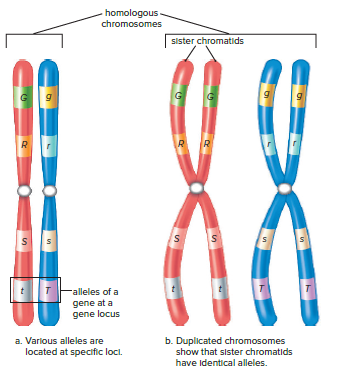
Genotype Versus Phenotype
Genotype: The genetic makeup of an organism, which is determined by the alleles it inherits from its parents.
Phenotype: The physical appearance of an organism, which is determined by its genotype and the environment in which it lives.
Alleles: Alternative forms of a gene.
Homozygous: Having two identical alleles for a trait.
Heterozygous: Having two different alleles for a trait.
Dominant allele: An allele that is expressed in the phenotype, even if the organism also has a recessive allele for the same trait.
Recessive allele: An allele that is only expressed in the phenotype if the organism does not have any dominant alleles for the same trait.

Two-Trait Inheritance
Mendel performed a second series of crosses, called dihybrid crosses, in which he crossed true-breeding plants that differed in two traits.
For example, he crossed tall plants with green pods (TTGG) with short plants with yellow pods (ttgg).
The F1 plants were all heterozygous for both traits, and were tall with green pods.
When the F1 plants were interbred, the F2 generation showed a 9:3:3:1 phenotypic ratio.
This means that 9/16 of the F2 plants were tall with green pods, 3/16 were tall with yellow pods, 3/16 were short with green pods, and 1/16 were short with yellow pods.
The 9:3:3:1 phenotypic ratio is expected when both parents are heterozygous for both traits.
However, other ratios are possible if the parents are not heterozygous for both traits.
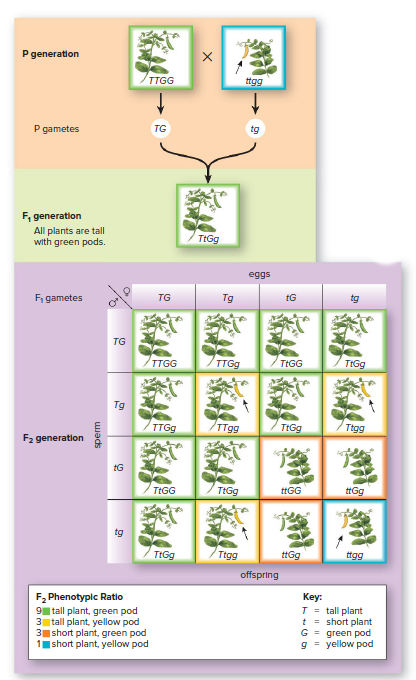
Two-Trait Testcross
Drosophila melanogaster, the fruit fly, is a favorite subject for genetic research because it has several mutant characteristics that are easily determined.
The wild-type fly has long wings and a gray body, while some mutant flies have short wings and black bodies.
The key for a cross involving these traits is:
L = long wings
l = short wings
G = gray body
g = black body
A two-trait testcross can be used to determine whether an individual is homozygous dominant or heterozygous for either of the two traits.
In a two-trait testcross, an individual with the dominant phenotype for both traits is crossed with an individual with the recessive phenotype for both traits.
The heterozygous parent fly forms four different types of gametes.
The offspring will show a 1:1:1:1 phenotypic ratio.
This shows that the L__G__ fly is heterozygous for both traits and has the genotype LlGg.
The chances of an offspring with long wings and a gray body are 25%.
The chances of an offspring with short wings and a gray body are also 25%.
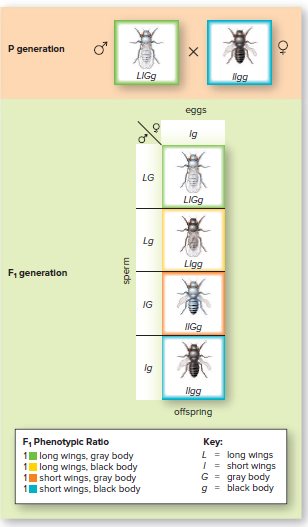
Mendel’s Laws and Probability
Importance of Mendel's Work:
Mendel's work connected observed patterns of inheritance and probability.
The Punnett square assumes each gamete has one allele for each trait (law of segregation) and all possible combinations of alleles (law of independent assortment).
Male and female gametes combine at random, giving all possible sperm an equal chance to fertilize all possible eggs.
The rules of probability can be used to calculate the expected phenotypic ratio.
The rule of multiplication states that the chance of two or more independent events occurring together is the product of their chances of occurring separately.
For example, the chance of getting tails when you toss a coin is 1/2. The chance of getting two tails when you toss two coins at once is 1/2 x 1/2 = 1/4.
Mendel’s Laws and Meiosis
During meiosis, homologous chromosomes (chromosomes that are similar in size and structure) are separated and each gamete (sex cell) receives one of each chromosome.
The process of homologous chromosome separation is called segregation.
Segregation is independent, meaning that it does not matter which homologous chromosome from a pair goes into a gamete.
As a result of segregation, each gamete has a random combination of chromosomes from the parent cell.
In Figure 10.8, the alleles A and a are on one pair of homologous chromosomes, and the alleles B and b are on the other pair of homologous chromosomes.
Because of segregation, a gamete can receive either an A or an a and either a B or a b in any combination.
This means that all possible combinations of alleles are present in the gametes.

10.2 Mendel’s Laws Apply to Humans
Traits and disorders in humans and other organisms are often genetic and follow Mendel's laws.
These traits are controlled by a single pair of alleles on the autosomal chromosomes.
Autosomes are any chromosomes that are not sex chromosomes (X or Y).
Family Pedigrees
A pedigree is a chart that shows the genetic relationships within a family.
Males are represented by squares and females are represented by circles.
Shaded squares and circles represent individuals who express the genetic trait (often a disorder).
A line between a square and a circle represents a union between two individuals.
A vertical line going downward from a square or circle represents a child.
If there are multiple children, they are placed off a horizontal line.
Generations are often numbered down the left side of the pedigree.
Individuals are then identified from left to right within each generation.
The analysis of a pedigree can be used to determine the probability of inheriting a genetic trait or disorder.
This information can be used by genetic counselors to help families make informed decisions about reproduction.
Pedigrees for Autosomal Disorders
Autosomal recessive disorders are caused by mutations in genes that are located on autosomes, which are the 22 pairs of chromosomes that are not sex chromosomes.
In order for an individual to have an autosomal recessive disorder, they must inherit two copies of the mutated gene, one from each parent.
If an individual only inherits one copy of the mutated gene, they will be a carrier of the disorder, but they will not show any signs or symptoms of the disorder.
Carriers of autosomal recessive disorders can pass the mutated gene on to their children, but their children will only have the disorder if they inherit two copies of the mutated gene.
The probability of a child inheriting an autosomal recessive disorder from their parents is 25%.
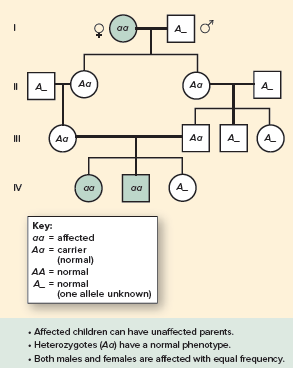
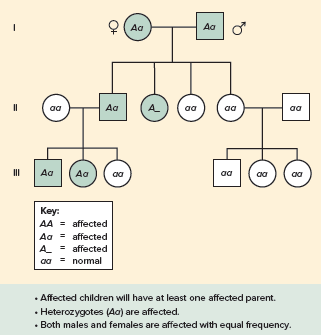
Genetic Disorders of Interest
Autosomal disorders are caused by mutations in genes located on autosomes, which are the 22 pairs of chromosomes that are not sex chromosomes.
Recessive disorders are only expressed if an individual inherits two copies of the mutated gene, one from each parent.
Dominant disorders are expressed if an individual inherits even a single copy of the mutated gene.
Methemoglobinemia
Methemoglobinemia is an autosomal recessive disorder caused by an accumulation of methemoglobin in the blood.
Methemoglobin is blue in color, which causes the skin of people with the disorder to appear bluish-purple.
The Fugates of Troublesome Creek in Kentucky were a family with the disorder.
A physician tested the Fugates for the enzyme diaphorase and found that they lacked the enzyme.
The enzyme diaphorase normally converts methemoglobin back to hemoglobin.
The physician treated a patient with methemoglobinemia by injecting a dye called methylene blue.
Methylene blue is a strong reducing agent that converts methemoglobin back into hemoglobin.
The patient's skin quickly turned pink again after the treatment.

Cystic Fibrosis
Cystic fibrosis is an autosomal recessive disorder that affects all ethnic groups.
It is the most common lethal genetic disorder among Caucasians in the United States.
Chloride ions (Cl–) fail to pass through a plasma membrane channel protein in the cells of these patients.
Sodium ions (Na+) and water follow chloride ions through the membrane.
Lack of water passing out of the cells causes abnormally thick mucus in the bronchial tubes and pancreatic ducts.
Thick mucus in the lungs must be loosened periodically to ease breathing in affected children.
The lungs become infected frequently despite loosening the mucus.
Clogged pancreatic ducts prevent digestive enzymes from reaching the small intestine.
Patients take digestive enzymes mixed with applesauce before every meal to improve digestion.
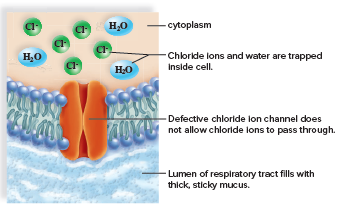
Alkaptonuria
Black urine disease or alkaptonuria, is a rare genetic disorder.
It follows an autosomal recessive inheritance pattern.
People with alkaptonuria lack a functional copy of the homogentisate oxygenase (HGD) gene found on chromosome 3.
The HGD enzyme breaks down homogentisic acid, but when it's missing, homogentisic acid accumulates in the blood and is passed into the urine.
Homogentisic acid turns black on exposure to air, giving the urine a characteristic color and odor.
Homogentisic acid also accumulates in joint spaces and connective tissues, leading to darkening of the tissues and eventually arthritis by adulthood.
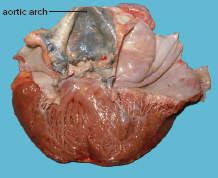
Sickle-Cell Disease
Sickle-cell disease is an autosomal recessive disorder.
Red blood cells in sickle-cell disease are irregular in shape and many are sickle-shaped.
A single base change in the globin gene causes the hemoglobin in affected individuals to differ from normal hemoglobin by a single amino acid.
Abnormal hemoglobin molecules stack up and form insoluble rods, causing red blood cells to become sickle-shaped.
Sickle-shaped cells clog vessels and break down, leading to poor circulation, anemia, and low resistance to infection.
Internal hemorrhaging can cause jaundice, episodic pain in the abdomen and joints, and damage to internal organs.
Sickle-cell heterozygotes have normal blood cells but carry the sickle-cell trait.
Heterozygotes are generally healthy and do not need to restrict their physical activity.
There may be problems if they experience dehydration or mild oxygen deprivation.
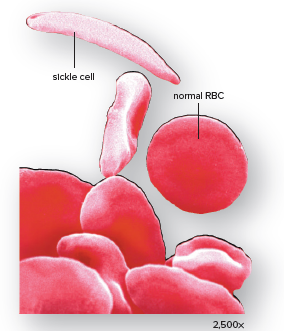
Osteogenesis Imperfecta
Osteogenesis imperfecta is a genetic disorder that causes weakened and brittle bones.
Most types of the disorder are linked to mutations in two genes necessary for the synthesis of type I collagen.
Type I collagen is an abundant protein in the human body that provides strength and rigidity to bone and forms the framework for most of the body's tissues.
Osteogenesis imperfecta leads to a defective type I collagen that causes bones to be brittle and weak.
The disorder is generally considered dominant because the mutant collagen can cause structural defects even when combined with normal type I collagen.
Osteogenesis imperfecta affects all racial groups similarly and has an incidence of approximately 1 in 5,000 live births.
The disorder has been documented as long as 300 years ago, and some historians think that the Viking chieftain Ivar the Boneless had this condition.
Diagnosis is usually made in young children who frequently visit the emergency room due to broken bones.
Some children with the disorder have an unusual blue tint in the sclera, reduced skin elasticity, weakened teeth, and occasionally heart valve abnormalities.
The disorder is treatable with drugs that help increase bone mass, but these drugs must be taken long-term.
Huntington Disease
Huntington disease is a dominant neurological disorder that causes progressive degeneration of neurons in the brain.
It is caused by a single mutated copy of the gene for a protein called huntingtin.
Most patients appear normal until they are middle-aged and have already had children, who may also have the inherited disorder.
There is no effective treatment, and death usually occurs 10 to 15 years after the onset of symptoms.
The gene for Huntington disease is located on chromosome 4.
A test was developed for the presence of the gene, but few people want to know if they have inherited the gene because there is no cure.
The disease stems from an unusual mutation that causes the huntingtin protein to have a series of extra glutamines.
Mutant huntingtin may contain 36 or more glutamines, which causes the protein to change shape and form large clumps inside neurons.
Mutant huntingtin also attracts and causes other proteins to clump with it, including CBP, which helps nerve cells survive.
Researchers hope to combat the disease by boosting CBP levels.
10.3 Beyond Mendel’s Laws
Some alleles are neither dominant nor recessive. These are called codominant alleles.
Some genes have more than two alleles. These are called multiple alleles.
Some traits are affected by more than one pair of genes. These are called complex traits.
Some traits are affected by the environment.
Incomplete Dominance
Incomplete dominance is when the heterozygote has a phenotype that is intermediate between the two homozygotes.
An example of incomplete dominance is when a curly-haired individual has children with a straight-haired individual, and their children have wavy hair.
The expected phenotypic ratio among the offspring of two wavy-haired persons is 1:2:1, with one curly-haired child, two with wavy hair, and one with straight hair.
Incomplete dominance can be explained by assuming that the dominant allele encodes for a gene product that is not completely capable of masking the recessive allele.
Familial hypercholesterolemia is another example of incomplete dominance in humans.
This disease is due to a variation in the number of LDL-cholesterol receptor proteins in the plasma membrane.
A person with two mutated alleles lacks LDL-cholesterol receptors, while a person with only one mutated allele has half the normal number of receptors.
People with the full number of receptors do not have familial hypercholesterolemia.
When receptors are completely absent, excessive cholesterol is deposited in various places in the body, including under the skin.
The presence of excessive cholesterol in the blood contributes to the development of cardiovascular disease.
Those with no LDL-cholesterol receptors die of cardiovascular disease as children, while individuals with half the number of receptors may die when young or after they have reached middle age.
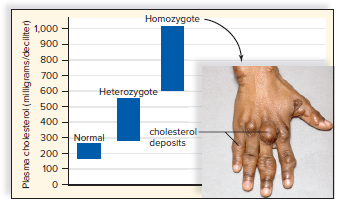
Multiple-Allele Traits
There are three alleles that determine the presence or absence of antigens on red blood cells: IA, IB, and i.
IA and IB are dominant over i.
Type A blood can be caused by the genotypes IAIA or IAi.
Type B blood can be caused by the genotypes IBIB or IBi.
Type O blood can only result from the genotype ii.
Type AB blood is caused by the genotype IAIB.
Codominance is a type of inheritance where both alleles are fully expressed.
In type AB blood, both A and B antigens appear on the red blood cells.

Polygenic Inheritance
Polygenic traits are governed by multiple genes, each with several sets of alleles.
Each allele has a quantitative effect on the phenotype.
Dominant alleles produce a gene product with an additive effect, while recessive alleles produce little or no effect.
The result is a continuous variation of phenotypes, resulting in a distribution of these phenotypes that resembles a bell-shaped curve.
The more genes involved, the more continuous the variations and distribution of the phenotypes.
Human height is an example of a polygenic trait.
Genomic studies have indicated that there may be as many as 700 different alleles that influence phenotypes for human height.
The combination of these genes produces minor additive effects and a characteristic bell-shaped distribution of phenotypes (Fig. 10.18).
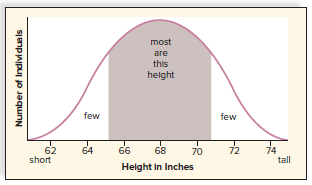
Environmental Influences
Environmental effects can influence the range of phenotypes associated with polygenic traits, producing a multifactorial trait.
Height and skin color are examples of multifactorial traits in humans.
Skin color is a polygenic trait influenced by over 100 different genes and environmental factors such as sunlight exposure and temperature.
Many genetic disorders are likely multifactorial due to the combined action of many genes and environmental influences.
Multifactorial traits are a challenge for drug manufacturers as they must determine the response to a new drug based on genetic and environmental factors.
The study of multifactorial traits contributes to our understanding of the nature versus nurture debate.
Identical twins are more similar in their intellectual talents, personality traits, and levels of lifelong happiness than are fraternal twins separated from birth.
Behavioral traits are partly determined by inheritance and genes for these traits act together in complex combinations to produce a phenotype modified by environmental influences.
Pleiotropy
Pleiotropy is when a single gene has multiple effects.
This often leads to a group of symptoms called a syndrome.
Marfan syndrome is an example of pleiotropy.
People with Marfan syndrome have long limbs, weakened aorta, and poor eyesight due to abnormal connective tissue.
Marfan syndrome is caused by a mutated gene (FBN1) on chromosome 15.
FBN1 gene normally specifies a protein called fibrillin, which is essential for the formation of elastic fibers in connective tissue.
Without normal connective tissue, the aorta can burst, especially during strenuous activities.
Other examples of pleiotropic traits include sickle-cell disease and porphyria.
Porphyria is caused by a chemical insufficiency in the production of hemoglobin.
Symptoms of porphyria include photosensitivity, abdominal pain, port-wine-colored urine, and paralysis in the arms and legs.
The British royal family in the late 1700s and early 1800s suffered from porphyria.
Vampire legends may be based on individuals with a specific form of porphyria.
Linkage
Linkage groups are groups of genes that are located on the same chromosome.
Alleles within a linkage group are inherited together more often than would be expected by chance.
The frequency of recombination between alleles within a linkage group is used to construct genetic maps, which show the relative positions of genes on a chromosome.
Genetic maps can be used to predict the probability of offspring inheriting certain combinations of genes.
10.4 Sex-Linked Inheritance
Normally, males and females have 23 pairs of chromosomes; 22 pairs are autosomes and 1 pair is sex chromosomes.
In humans, males have X and Y chromosomes, while females have two X chromosomes.
The Y chromosome is much shorter and contains fewer than 200 genes, most of which are concerned with sex differences.
The X chromosome is larger and contains nearly 2,000 genes, most of which are not related to gender.
The SRY gene on the Y chromosome determines male sex development.
Female sex development is the "default setting."
X-linked genes refer to genes carried on the X chromosome, such as hemophilia and red-green color blindness.
A male always receives an X-linked allele from his mother, while the Y chromosome from the father does not carry an allele for the trait.
Usually, a sex-linked genetic disorder is recessive, so a female must receive two alleles to develop the condition.
Sex-Linked Alleles
For X-linked traits, the allele on the X chromosome is shown as a letter attached to the X chromosome; following is the key for red-green color blindness, a well-known X-linked recessive disorder.
XB = normal vision
Xb = color blindness
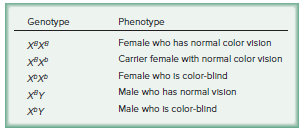
Pleiotropy is when a single gene has multiple effects, leading to a group of symptoms called a syndrome.
Marfan syndrome is an example of pleiotropy, caused by a mutated FBN1 gene on chromosome 15 that produces abnormal connective tissue.
Persons with Marfan syndrome have long limbs, weakened aorta, and poor eyesight.
Other examples of pleiotropic traits include sickle-cell disease and porphyria.
Porphyria is caused by a chemical insufficiency in the production of hemoglobin, leading to photosensitivity, abdominal pain, port-wine-colored urine, and paralysis.
The allele for color blindness is on the X chromosome, making color-blind females rare because they need to inherit the allele from both parents.
Color-blind males are more common because they only need one recessive allele to be color-blind.
A man with normal vision and a heterozygous woman have a 50% chance of having a color-blind son, but all daughters will have normal color vision.
Pedigrees for Sex-Linked Disorders
X-linked recessive inheritance:
Sons inherit X-linked recessive traits from their mother.
More males than females have the disorder.
Females who have the condition inherited the allele from both their mother and their father.
All the sons of a female with the condition will have the condition.
If a male has an X-linked recessive condition, his daughters are all carriers.
X-linked recessive conditions often appear to pass from grandfather to grandson.
X-linked dominant inheritance:
Fewer traits are known to be X-linked dominant.
Daughters of affected males have a 100% chance of having the condition.
Females can pass an X-linked dominant allele to both sons and daughters.
If a female is heterozygous and her partner is normal, each child has a 50% chance of escaping the disorder.
Y-linked inheritance:
Fewer genetic disorders involve genes carried on the Y chromosome.
Y-linked disorders are present only in males.
Y-linked disorders are passed directly from a father to all sons but not to daughters.
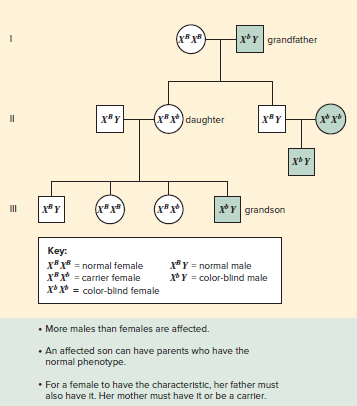
X-Linked Recessive Disorders
Color Blindness
Red-green color blindness is an X-linked recessive disorder.
8% of Caucasian men have this disorder.
Those affected see brighter greens as tans, olive greens as browns, and reds as reddish-browns.
Some individuals with this disorder cannot distinguish between reds and greens at all.
They are only able to see yellows, blues, blacks, whites, and grays.
Duchenne Muscular Dystrophy
Duchenne muscular dystrophy is an X-linked recessive disorder.
It is characterized by wasting away of the muscles.
The absence of a protein called dystrophin is the cause of the disorder.
Dystrophin is involved in the release of calcium from the sarcoplasmic reticulum in muscle fibers.
Lack of dystrophin causes calcium to leak into the cell, which promotes the action of an enzyme that dissolves muscle fibers.
Fibrous tissue forms when the body attempts to repair the tissue, cutting off the blood supply, causing more cells to die.
Symptoms include waddling gait, toe walking, frequent falls, and difficulty in rising.
Muscle weakness intensifies until the individual is confined to a wheelchair.
Death usually occurs by age 20.
Immature muscle cells can be injected into muscles as therapy.
For every 100,000 cells injected, dystrophin production occurs in 30-40% of muscle fibers.
The recessive allele remains in the population through passage from carrier mother to carrier daughter.
Chapter 10: Patterns of Inheritance
10.1 Mendel’s Laws
Genetics is the science of heredity, or how traits are passed from parents to offspring.
Genetics can explain why you share similar characteristics with your relatives, such as eye color, hair color, and height.
Genetics can also explain why there are variations between offspring from one generation to the next.
Virtually every culture in history has attempted to explain observed inheritance patterns.
An understanding of inheritance patterns has always been important to agriculture, animal husbandry, and medicine.
Mendel’s Experimental Procedure
Gregor Mendel was an Austrian monk and scientist who conducted experiments on pea plants in the 1860s.
Mendel's experiments led to the development of the laws of inheritance, which explain how traits are passed from parents to offspring.
Mendel's laws of inheritance are:
The law of segregation: Each parent passes on only one of its two copies of a gene to its offspring.
The law of independent assortment: The genes for different traits are passed on to offspring independently of each other.
Mendel’s theory is called the particulate theory of inheritance because it is based on the existence of minute particles that we now call genes.
Inheritance involves the reshuffling of these genes from generation to generation.
Mendel's work was groundbreaking and laid the foundation for modern genetics.

One-Trait Inheritance
Mendel ensured that his pea plants were true-breeding, meaning that they always produced offspring with the same trait as themselves.
For example, Mendel's green-pod plants always produced green-pod offspring, and his yellow-pod plants always produced yellow-pod offspring.
Once Mendel had confirmed that his pea plants were true-breeding, he was ready to perform a cross between two different strains.
Mendel called the original parents the P generation.
The first-generation offspring were called the F1 (for filial) generation.
The second-generation offspring were called the F2 generation.



A Punnett square is a diagram that shows all the possible combinations of genes that can be inherited by offspring.
When Mendel crossed green-pod plants with yellow-pod plants, all the F1 offspring (first generation) resembled the green-pod parent.
This did not mean that the yellow-pod trait had disappeared permanently.
When Mendel allowed the F1 plants to self-pollinate, three-fourths of the F2 generation (second generation) produced green pods and one-fourth produced yellow pods.
This 3:1 ratio is evidence that the F1 plants had passed on a factor for the yellow color.
Mendel recognized that the F1 plants produced green pods because the green color was dominant over the yellow color.
This type of cross is commonly called a monohybrid cross.
Mendel's mathematical approach led him to conclude that the following must be true in order to produce a 3:1 ratio in the F2 generation:
The F1 parents contained two separate copies of each hereditary factor, one dominant and one recessive.
The factors separated when the gametes were formed, and each gamete carried only one copy of each factor.
Random fusion of all possible gametes occurred upon fertilization.
One-Trait Testcross
Mendel performed a testcross to determine whether the F1 generation carried a recessive factor.
In a testcross, an individual with a dominant phenotype is crossed with an individual with a recessive phenotype.
If the individual with the dominant phenotype is heterozygous, then half of the offspring will have the recessive phenotype.
Mendel's results from the testcross supported his hypothesis that factors segregate when gametes are formed.
The law of segregation states that:
Each individual has two factors for each trait.
The factors segregate (separate) during the formation of the gametes.
Each gamete contains only one factor from each pair of factors.
Fertilization gives each new individual two factors for each trait.

The Modern Interpretation of Mendel’s Work
In the early 1900s, scientists noticed that Mendel's "factors" (now known as genes) behaved in a similar way to chromosomes.
This led to the development of the chromosomal theory of inheritance, which states that genes are located on chromosomes.
Each gene has two copies, called alleles.
The dominant allele is expressed, while the recessive allele is not.
Dominant alleles are denoted by uppercase letters, while recessive alleles are denoted by lowercase letters.
Alleles on homologous chromosomes can be different.
Sister chromatids always have the same alleles.
Genes act as blueprints for traits at the physiological and cellular level.
Environmental factors and gene expression can modify the expression of genes.
During meiosis I, homologous chromosomes (chromosomes that are similar in size and shape) pair up and exchange genetic material.
After meiosis I, each gamete (sex cell) has one copy of each chromosome.
When two gametes fuse during fertilization, the resulting zygote (fertilized egg) has two copies of each chromosome, one from each parent.

Genotype Versus Phenotype
Genotype: The genetic makeup of an organism, which is determined by the alleles it inherits from its parents.
Phenotype: The physical appearance of an organism, which is determined by its genotype and the environment in which it lives.
Alleles: Alternative forms of a gene.
Homozygous: Having two identical alleles for a trait.
Heterozygous: Having two different alleles for a trait.
Dominant allele: An allele that is expressed in the phenotype, even if the organism also has a recessive allele for the same trait.
Recessive allele: An allele that is only expressed in the phenotype if the organism does not have any dominant alleles for the same trait.

Two-Trait Inheritance
Mendel performed a second series of crosses, called dihybrid crosses, in which he crossed true-breeding plants that differed in two traits.
For example, he crossed tall plants with green pods (TTGG) with short plants with yellow pods (ttgg).
The F1 plants were all heterozygous for both traits, and were tall with green pods.
When the F1 plants were interbred, the F2 generation showed a 9:3:3:1 phenotypic ratio.
This means that 9/16 of the F2 plants were tall with green pods, 3/16 were tall with yellow pods, 3/16 were short with green pods, and 1/16 were short with yellow pods.
The 9:3:3:1 phenotypic ratio is expected when both parents are heterozygous for both traits.
However, other ratios are possible if the parents are not heterozygous for both traits.

Two-Trait Testcross
Drosophila melanogaster, the fruit fly, is a favorite subject for genetic research because it has several mutant characteristics that are easily determined.
The wild-type fly has long wings and a gray body, while some mutant flies have short wings and black bodies.
The key for a cross involving these traits is:
L = long wings
l = short wings
G = gray body
g = black body
A two-trait testcross can be used to determine whether an individual is homozygous dominant or heterozygous for either of the two traits.
In a two-trait testcross, an individual with the dominant phenotype for both traits is crossed with an individual with the recessive phenotype for both traits.
The heterozygous parent fly forms four different types of gametes.
The offspring will show a 1:1:1:1 phenotypic ratio.
This shows that the L__G__ fly is heterozygous for both traits and has the genotype LlGg.
The chances of an offspring with long wings and a gray body are 25%.
The chances of an offspring with short wings and a gray body are also 25%.

Mendel’s Laws and Probability
Importance of Mendel's Work:
Mendel's work connected observed patterns of inheritance and probability.
The Punnett square assumes each gamete has one allele for each trait (law of segregation) and all possible combinations of alleles (law of independent assortment).
Male and female gametes combine at random, giving all possible sperm an equal chance to fertilize all possible eggs.
The rules of probability can be used to calculate the expected phenotypic ratio.
The rule of multiplication states that the chance of two or more independent events occurring together is the product of their chances of occurring separately.
For example, the chance of getting tails when you toss a coin is 1/2. The chance of getting two tails when you toss two coins at once is 1/2 x 1/2 = 1/4.
Mendel’s Laws and Meiosis
During meiosis, homologous chromosomes (chromosomes that are similar in size and structure) are separated and each gamete (sex cell) receives one of each chromosome.
The process of homologous chromosome separation is called segregation.
Segregation is independent, meaning that it does not matter which homologous chromosome from a pair goes into a gamete.
As a result of segregation, each gamete has a random combination of chromosomes from the parent cell.
In Figure 10.8, the alleles A and a are on one pair of homologous chromosomes, and the alleles B and b are on the other pair of homologous chromosomes.
Because of segregation, a gamete can receive either an A or an a and either a B or a b in any combination.
This means that all possible combinations of alleles are present in the gametes.

10.2 Mendel’s Laws Apply to Humans
Traits and disorders in humans and other organisms are often genetic and follow Mendel's laws.
These traits are controlled by a single pair of alleles on the autosomal chromosomes.
Autosomes are any chromosomes that are not sex chromosomes (X or Y).
Family Pedigrees
A pedigree is a chart that shows the genetic relationships within a family.
Males are represented by squares and females are represented by circles.
Shaded squares and circles represent individuals who express the genetic trait (often a disorder).
A line between a square and a circle represents a union between two individuals.
A vertical line going downward from a square or circle represents a child.
If there are multiple children, they are placed off a horizontal line.
Generations are often numbered down the left side of the pedigree.
Individuals are then identified from left to right within each generation.
The analysis of a pedigree can be used to determine the probability of inheriting a genetic trait or disorder.
This information can be used by genetic counselors to help families make informed decisions about reproduction.
Pedigrees for Autosomal Disorders
Autosomal recessive disorders are caused by mutations in genes that are located on autosomes, which are the 22 pairs of chromosomes that are not sex chromosomes.
In order for an individual to have an autosomal recessive disorder, they must inherit two copies of the mutated gene, one from each parent.
If an individual only inherits one copy of the mutated gene, they will be a carrier of the disorder, but they will not show any signs or symptoms of the disorder.
Carriers of autosomal recessive disorders can pass the mutated gene on to their children, but their children will only have the disorder if they inherit two copies of the mutated gene.
The probability of a child inheriting an autosomal recessive disorder from their parents is 25%.


Genetic Disorders of Interest
Autosomal disorders are caused by mutations in genes located on autosomes, which are the 22 pairs of chromosomes that are not sex chromosomes.
Recessive disorders are only expressed if an individual inherits two copies of the mutated gene, one from each parent.
Dominant disorders are expressed if an individual inherits even a single copy of the mutated gene.
Methemoglobinemia
Methemoglobinemia is an autosomal recessive disorder caused by an accumulation of methemoglobin in the blood.
Methemoglobin is blue in color, which causes the skin of people with the disorder to appear bluish-purple.
The Fugates of Troublesome Creek in Kentucky were a family with the disorder.
A physician tested the Fugates for the enzyme diaphorase and found that they lacked the enzyme.
The enzyme diaphorase normally converts methemoglobin back to hemoglobin.
The physician treated a patient with methemoglobinemia by injecting a dye called methylene blue.
Methylene blue is a strong reducing agent that converts methemoglobin back into hemoglobin.
The patient's skin quickly turned pink again after the treatment.

Cystic Fibrosis
Cystic fibrosis is an autosomal recessive disorder that affects all ethnic groups.
It is the most common lethal genetic disorder among Caucasians in the United States.
Chloride ions (Cl–) fail to pass through a plasma membrane channel protein in the cells of these patients.
Sodium ions (Na+) and water follow chloride ions through the membrane.
Lack of water passing out of the cells causes abnormally thick mucus in the bronchial tubes and pancreatic ducts.
Thick mucus in the lungs must be loosened periodically to ease breathing in affected children.
The lungs become infected frequently despite loosening the mucus.
Clogged pancreatic ducts prevent digestive enzymes from reaching the small intestine.
Patients take digestive enzymes mixed with applesauce before every meal to improve digestion.

Alkaptonuria
Black urine disease or alkaptonuria, is a rare genetic disorder.
It follows an autosomal recessive inheritance pattern.
People with alkaptonuria lack a functional copy of the homogentisate oxygenase (HGD) gene found on chromosome 3.
The HGD enzyme breaks down homogentisic acid, but when it's missing, homogentisic acid accumulates in the blood and is passed into the urine.
Homogentisic acid turns black on exposure to air, giving the urine a characteristic color and odor.
Homogentisic acid also accumulates in joint spaces and connective tissues, leading to darkening of the tissues and eventually arthritis by adulthood.

Sickle-Cell Disease
Sickle-cell disease is an autosomal recessive disorder.
Red blood cells in sickle-cell disease are irregular in shape and many are sickle-shaped.
A single base change in the globin gene causes the hemoglobin in affected individuals to differ from normal hemoglobin by a single amino acid.
Abnormal hemoglobin molecules stack up and form insoluble rods, causing red blood cells to become sickle-shaped.
Sickle-shaped cells clog vessels and break down, leading to poor circulation, anemia, and low resistance to infection.
Internal hemorrhaging can cause jaundice, episodic pain in the abdomen and joints, and damage to internal organs.
Sickle-cell heterozygotes have normal blood cells but carry the sickle-cell trait.
Heterozygotes are generally healthy and do not need to restrict their physical activity.
There may be problems if they experience dehydration or mild oxygen deprivation.

Osteogenesis Imperfecta
Osteogenesis imperfecta is a genetic disorder that causes weakened and brittle bones.
Most types of the disorder are linked to mutations in two genes necessary for the synthesis of type I collagen.
Type I collagen is an abundant protein in the human body that provides strength and rigidity to bone and forms the framework for most of the body's tissues.
Osteogenesis imperfecta leads to a defective type I collagen that causes bones to be brittle and weak.
The disorder is generally considered dominant because the mutant collagen can cause structural defects even when combined with normal type I collagen.
Osteogenesis imperfecta affects all racial groups similarly and has an incidence of approximately 1 in 5,000 live births.
The disorder has been documented as long as 300 years ago, and some historians think that the Viking chieftain Ivar the Boneless had this condition.
Diagnosis is usually made in young children who frequently visit the emergency room due to broken bones.
Some children with the disorder have an unusual blue tint in the sclera, reduced skin elasticity, weakened teeth, and occasionally heart valve abnormalities.
The disorder is treatable with drugs that help increase bone mass, but these drugs must be taken long-term.
Huntington Disease
Huntington disease is a dominant neurological disorder that causes progressive degeneration of neurons in the brain.
It is caused by a single mutated copy of the gene for a protein called huntingtin.
Most patients appear normal until they are middle-aged and have already had children, who may also have the inherited disorder.
There is no effective treatment, and death usually occurs 10 to 15 years after the onset of symptoms.
The gene for Huntington disease is located on chromosome 4.
A test was developed for the presence of the gene, but few people want to know if they have inherited the gene because there is no cure.
The disease stems from an unusual mutation that causes the huntingtin protein to have a series of extra glutamines.
Mutant huntingtin may contain 36 or more glutamines, which causes the protein to change shape and form large clumps inside neurons.
Mutant huntingtin also attracts and causes other proteins to clump with it, including CBP, which helps nerve cells survive.
Researchers hope to combat the disease by boosting CBP levels.
10.3 Beyond Mendel’s Laws
Some alleles are neither dominant nor recessive. These are called codominant alleles.
Some genes have more than two alleles. These are called multiple alleles.
Some traits are affected by more than one pair of genes. These are called complex traits.
Some traits are affected by the environment.
Incomplete Dominance
Incomplete dominance is when the heterozygote has a phenotype that is intermediate between the two homozygotes.
An example of incomplete dominance is when a curly-haired individual has children with a straight-haired individual, and their children have wavy hair.
The expected phenotypic ratio among the offspring of two wavy-haired persons is 1:2:1, with one curly-haired child, two with wavy hair, and one with straight hair.
Incomplete dominance can be explained by assuming that the dominant allele encodes for a gene product that is not completely capable of masking the recessive allele.
Familial hypercholesterolemia is another example of incomplete dominance in humans.
This disease is due to a variation in the number of LDL-cholesterol receptor proteins in the plasma membrane.
A person with two mutated alleles lacks LDL-cholesterol receptors, while a person with only one mutated allele has half the normal number of receptors.
People with the full number of receptors do not have familial hypercholesterolemia.
When receptors are completely absent, excessive cholesterol is deposited in various places in the body, including under the skin.
The presence of excessive cholesterol in the blood contributes to the development of cardiovascular disease.
Those with no LDL-cholesterol receptors die of cardiovascular disease as children, while individuals with half the number of receptors may die when young or after they have reached middle age.

Multiple-Allele Traits
There are three alleles that determine the presence or absence of antigens on red blood cells: IA, IB, and i.
IA and IB are dominant over i.
Type A blood can be caused by the genotypes IAIA or IAi.
Type B blood can be caused by the genotypes IBIB or IBi.
Type O blood can only result from the genotype ii.
Type AB blood is caused by the genotype IAIB.
Codominance is a type of inheritance where both alleles are fully expressed.
In type AB blood, both A and B antigens appear on the red blood cells.

Polygenic Inheritance
Polygenic traits are governed by multiple genes, each with several sets of alleles.
Each allele has a quantitative effect on the phenotype.
Dominant alleles produce a gene product with an additive effect, while recessive alleles produce little or no effect.
The result is a continuous variation of phenotypes, resulting in a distribution of these phenotypes that resembles a bell-shaped curve.
The more genes involved, the more continuous the variations and distribution of the phenotypes.
Human height is an example of a polygenic trait.
Genomic studies have indicated that there may be as many as 700 different alleles that influence phenotypes for human height.
The combination of these genes produces minor additive effects and a characteristic bell-shaped distribution of phenotypes (Fig. 10.18).

Environmental Influences
Environmental effects can influence the range of phenotypes associated with polygenic traits, producing a multifactorial trait.
Height and skin color are examples of multifactorial traits in humans.
Skin color is a polygenic trait influenced by over 100 different genes and environmental factors such as sunlight exposure and temperature.
Many genetic disorders are likely multifactorial due to the combined action of many genes and environmental influences.
Multifactorial traits are a challenge for drug manufacturers as they must determine the response to a new drug based on genetic and environmental factors.
The study of multifactorial traits contributes to our understanding of the nature versus nurture debate.
Identical twins are more similar in their intellectual talents, personality traits, and levels of lifelong happiness than are fraternal twins separated from birth.
Behavioral traits are partly determined by inheritance and genes for these traits act together in complex combinations to produce a phenotype modified by environmental influences.
Pleiotropy
Pleiotropy is when a single gene has multiple effects.
This often leads to a group of symptoms called a syndrome.
Marfan syndrome is an example of pleiotropy.
People with Marfan syndrome have long limbs, weakened aorta, and poor eyesight due to abnormal connective tissue.
Marfan syndrome is caused by a mutated gene (FBN1) on chromosome 15.
FBN1 gene normally specifies a protein called fibrillin, which is essential for the formation of elastic fibers in connective tissue.
Without normal connective tissue, the aorta can burst, especially during strenuous activities.
Other examples of pleiotropic traits include sickle-cell disease and porphyria.
Porphyria is caused by a chemical insufficiency in the production of hemoglobin.
Symptoms of porphyria include photosensitivity, abdominal pain, port-wine-colored urine, and paralysis in the arms and legs.
The British royal family in the late 1700s and early 1800s suffered from porphyria.
Vampire legends may be based on individuals with a specific form of porphyria.
Linkage
Linkage groups are groups of genes that are located on the same chromosome.
Alleles within a linkage group are inherited together more often than would be expected by chance.
The frequency of recombination between alleles within a linkage group is used to construct genetic maps, which show the relative positions of genes on a chromosome.
Genetic maps can be used to predict the probability of offspring inheriting certain combinations of genes.
10.4 Sex-Linked Inheritance
Normally, males and females have 23 pairs of chromosomes; 22 pairs are autosomes and 1 pair is sex chromosomes.
In humans, males have X and Y chromosomes, while females have two X chromosomes.
The Y chromosome is much shorter and contains fewer than 200 genes, most of which are concerned with sex differences.
The X chromosome is larger and contains nearly 2,000 genes, most of which are not related to gender.
The SRY gene on the Y chromosome determines male sex development.
Female sex development is the "default setting."
X-linked genes refer to genes carried on the X chromosome, such as hemophilia and red-green color blindness.
A male always receives an X-linked allele from his mother, while the Y chromosome from the father does not carry an allele for the trait.
Usually, a sex-linked genetic disorder is recessive, so a female must receive two alleles to develop the condition.
Sex-Linked Alleles
For X-linked traits, the allele on the X chromosome is shown as a letter attached to the X chromosome; following is the key for red-green color blindness, a well-known X-linked recessive disorder.
XB = normal vision
Xb = color blindness

Pleiotropy is when a single gene has multiple effects, leading to a group of symptoms called a syndrome.
Marfan syndrome is an example of pleiotropy, caused by a mutated FBN1 gene on chromosome 15 that produces abnormal connective tissue.
Persons with Marfan syndrome have long limbs, weakened aorta, and poor eyesight.
Other examples of pleiotropic traits include sickle-cell disease and porphyria.
Porphyria is caused by a chemical insufficiency in the production of hemoglobin, leading to photosensitivity, abdominal pain, port-wine-colored urine, and paralysis.
The allele for color blindness is on the X chromosome, making color-blind females rare because they need to inherit the allele from both parents.
Color-blind males are more common because they only need one recessive allele to be color-blind.
A man with normal vision and a heterozygous woman have a 50% chance of having a color-blind son, but all daughters will have normal color vision.
Pedigrees for Sex-Linked Disorders
X-linked recessive inheritance:
Sons inherit X-linked recessive traits from their mother.
More males than females have the disorder.
Females who have the condition inherited the allele from both their mother and their father.
All the sons of a female with the condition will have the condition.
If a male has an X-linked recessive condition, his daughters are all carriers.
X-linked recessive conditions often appear to pass from grandfather to grandson.
X-linked dominant inheritance:
Fewer traits are known to be X-linked dominant.
Daughters of affected males have a 100% chance of having the condition.
Females can pass an X-linked dominant allele to both sons and daughters.
If a female is heterozygous and her partner is normal, each child has a 50% chance of escaping the disorder.
Y-linked inheritance:
Fewer genetic disorders involve genes carried on the Y chromosome.
Y-linked disorders are present only in males.
Y-linked disorders are passed directly from a father to all sons but not to daughters.

X-Linked Recessive Disorders
Color Blindness
Red-green color blindness is an X-linked recessive disorder.
8% of Caucasian men have this disorder.
Those affected see brighter greens as tans, olive greens as browns, and reds as reddish-browns.
Some individuals with this disorder cannot distinguish between reds and greens at all.
They are only able to see yellows, blues, blacks, whites, and grays.
Duchenne Muscular Dystrophy
Duchenne muscular dystrophy is an X-linked recessive disorder.
It is characterized by wasting away of the muscles.
The absence of a protein called dystrophin is the cause of the disorder.
Dystrophin is involved in the release of calcium from the sarcoplasmic reticulum in muscle fibers.
Lack of dystrophin causes calcium to leak into the cell, which promotes the action of an enzyme that dissolves muscle fibers.
Fibrous tissue forms when the body attempts to repair the tissue, cutting off the blood supply, causing more cells to die.
Symptoms include waddling gait, toe walking, frequent falls, and difficulty in rising.
Muscle weakness intensifies until the individual is confined to a wheelchair.
Death usually occurs by age 20.
Immature muscle cells can be injected into muscles as therapy.
For every 100,000 cells injected, dystrophin production occurs in 30-40% of muscle fibers.
The recessive allele remains in the population through passage from carrier mother to carrier daughter.
 Knowt
Knowt
